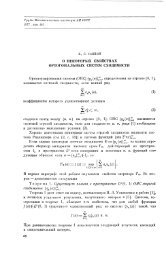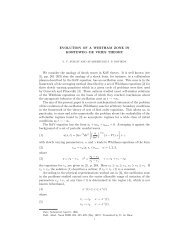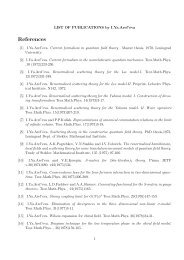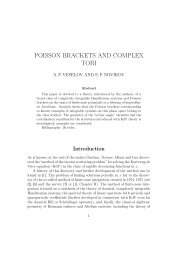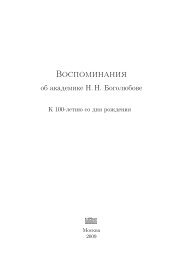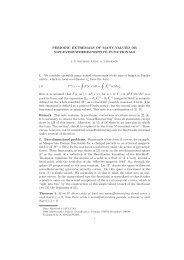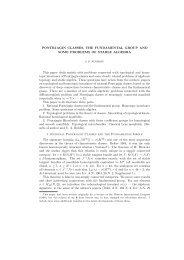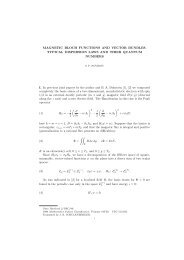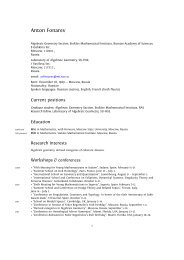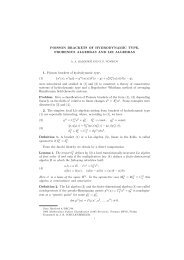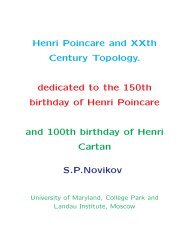A periodic problem for the Korteweg-de Vries equations, I.
A periodic problem for the Korteweg-de Vries equations, I.
A periodic problem for the Korteweg-de Vries equations, I.
You also want an ePaper? Increase the reach of your titles
YUMPU automatically turns print PDFs into web optimized ePapers that Google loves.
THE PERIODIC PROBLEM FOR THE KORTEWEG–DE VRIES EQUATION 3interaction has not been studied at all. In <strong>the</strong> present paper we propose a method ofstudying certain analogs of <strong>the</strong> “multisoliton” solutions of <strong>the</strong> KV equation which,generally speaking, are found to be not only <strong>periodic</strong>, but also conditionally <strong>periodic</strong>functions u(x) <strong>de</strong>scribing <strong>the</strong> interaction of <strong>periodic</strong> solitons. Our work is based oncertain simple but fundamental algebraic properties of <strong>equations</strong> admitting <strong>the</strong> Laxrepresentation which are strongly <strong>de</strong>generate in <strong>the</strong> <strong>problem</strong> with rapidly <strong>de</strong>creasingfunctions (<strong>for</strong> x → ±∞), and have <strong>the</strong>re<strong>for</strong>e not been noted. Finally, it is essentialto note <strong>the</strong> nonlinear “superposition law <strong>for</strong> waves” <strong>for</strong> <strong>the</strong> KV equation whichin <strong>the</strong> <strong>periodic</strong> case has an interesting algebraic-geometric interpretation. Thesuperposition law will be discussed in <strong>the</strong> second part of <strong>the</strong> work.In conclusion, we call <strong>the</strong> attention of <strong>the</strong> rea<strong>de</strong>r to <strong>the</strong> following circumstance:in classical mechanics and ma<strong>the</strong>matics <strong>the</strong> appearance of integrals in conservativesystems (conservation laws) is almost always related to a Lie symmetry group of<strong>the</strong> <strong>problem</strong> in question. O<strong>the</strong>r fundamental algebraic mechanisms of integrabilitywere previously unknown. However, <strong>the</strong>re were several exceptions: <strong>for</strong> example,<strong>the</strong> Jacobi case (geo<strong>de</strong>sics on a triaxial ellipsoid) or <strong>the</strong> case of Kovalevskaya (<strong>the</strong><strong>problem</strong> of <strong>the</strong> motion of a solid body with a fixed point in a gravitational field).O<strong>the</strong>r exceptional examples are now known. There is not <strong>the</strong> slightest doubt thatall <strong>the</strong>se cases are <strong>the</strong> manifestation of a Kruskal-type algebraic mechanism basedon <strong>the</strong> possibility of a Lax-type representation <strong>for</strong> <strong>the</strong>se dynamical systems.1. The Schrödinger (Sturm–Liouville) Equations with PeriodicCoefficients. The Monodromy MatrixWe shall first list systematically simple facts which we shall need.Let u(x) be a smooth function where u(x + T ) = u(x), and let L = (d 2 /dx 2 ) +u. We consi<strong>de</strong>r on <strong>the</strong> line <strong>the</strong> equation Lψ k = λψ k , where λ = k 2 is a realnumber. We consi<strong>de</strong>r <strong>the</strong> pair of linearly in<strong>de</strong>pen<strong>de</strong>nt solutions ψ k (x, x 0 ), ¯ψ k (x, x 0 ),where ψ k (x 0 , x 0 ) = 1, ψk ′ (x 0, x 0 ) = ik, or <strong>the</strong> pair φ k , ¯φ k , where φ k (x 0 , x 0 ) = 1,¯φ k (x 0 , x 0 ) = i. (The pair ψ k , ¯ψ k is more convenient but is meaningful only <strong>for</strong>k 2 > 0.) We can <strong>de</strong>fine <strong>the</strong> “monodromy matrix”whereT (k, x 0 ) =( ) a b, a = a(k, x ¯b ā 0 ), b = b(k, x 0 ),ψ k (x + T, x 0 ) = aψ k (x, x 0 ) + b ¯ψ k (x, x 0 ),¯ψ k (x + T, x 0 ) = ¯bψ k (x, x 0 ) + ā ¯ψ k (x, x 0 ),or <strong>the</strong> analogous matrix in ano<strong>the</strong>r basis. In <strong>the</strong> basis φ k , ¯φ k , <strong>for</strong> example, <strong>the</strong>monodromy matrix is an entire function of λ = k 2 . The trace of <strong>the</strong> matrix Sp T =a + ā = 2a R is real, while <strong>the</strong> <strong>de</strong>terminant is equal to one, <strong>de</strong>t T = |a| 2 − |b| 2 = 1<strong>for</strong> all real k, since <strong>the</strong> Wronskian <strong>de</strong>terminant is conserved.The eigenvalues of <strong>the</strong> matrix T (k, x 0 ) do not <strong>de</strong>pend on <strong>the</strong> point x 0 and have<strong>the</strong> <strong>for</strong>m: µ ± = a R ± √ a 2 R − 1. In particular, we have two cases: µ ± = e ±ip , |a R | ≤1; µ ± = e ±p , |a R | ≥ 1, where p is a real number (a R = cos p <strong>for</strong> |a R | ≤ 1). The Blocheigenfunctions of <strong>the</strong> operator L are those solutions of <strong>the</strong> equation Lf = k 2 f suchthat f(x+T ) = e ±ip f(x), where <strong>the</strong> number p is called <strong>the</strong> “quasi-momentum.” Wehave <strong>periodic</strong> eigenfunctions <strong>for</strong> e ip = 1 or a R = 1, and anti<strong>periodic</strong> eigenfunctionsf(x + T ) = −f(x), where a R = −1. The permitted zones are <strong>the</strong> regions on<strong>the</strong> axis λ = k 2 , where |a R | ≤ 1, and <strong>the</strong> <strong>for</strong>bid<strong>de</strong>n zones are <strong>the</strong> regions on <strong>the</strong>



